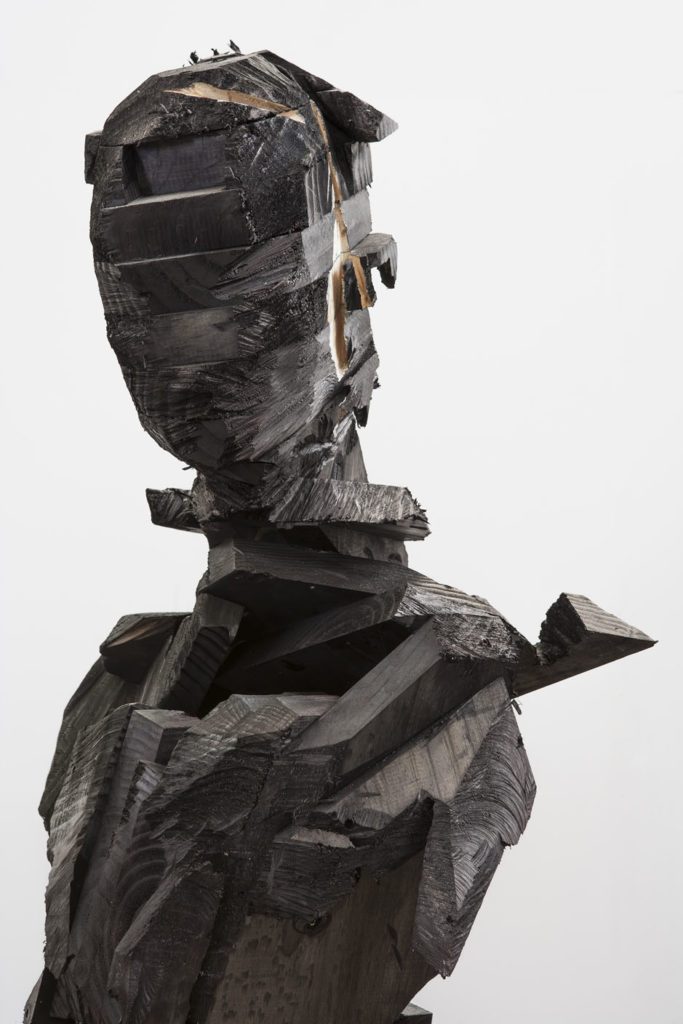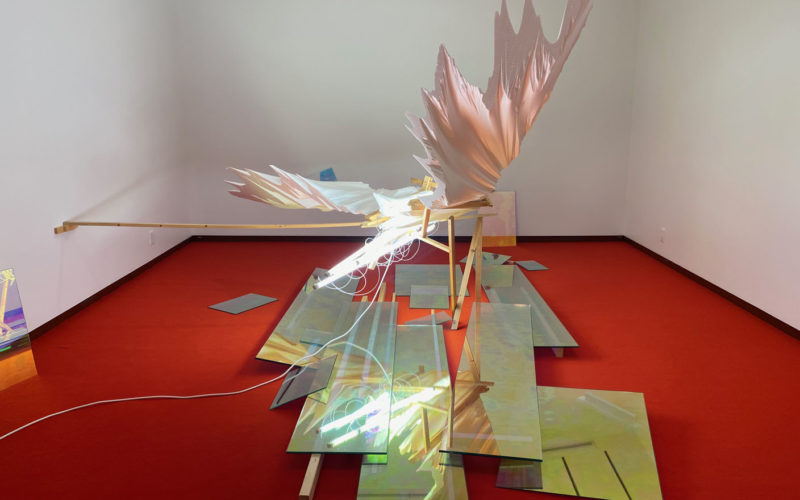April Wallace
awallace@nwaonline.com
This weekend 21c Bentonville Museum Hotel welcomed two new exhibitions, making it the first gallery transformation since the pandemic began.
Wim Botha’s “Still Life with Discontent” and “Truth or Dare: A Reality Show” will be on display until December.
On Jan. 22, patrons gathered in the event hall, seated six feet apart, as they listened to South African artist Wim Botha discuss the making of his works via a Zoom call with the museum curator. Botha’s pieces are a variety of sculpture, portrait busts and oil paintings that have underlying traditional influences, but closer inspection reveals the turmoil of modern life.
“It feels really good to have all new work,” says Alice Gray Stites, chief curator and museum director. “Botha’s work is powerful, and people are responding thoughtfully to having it here.”

Botha has exhibited all over the world, such as the 55th Biennale (Venice), the National Arts Festival in Grahamstown (South Africa) and Galerie Hans Mayer (Germany). He earned the prestigious Helgaard Steyn prize and the Standard Bank Young Artist award, among others.
“Still Life with Discontent” was shown first at 21c Durham and 21c Louisville. Its last stop is Bentonville. Botha says the name of the collection has to do with the influence of the world as it is right now.
“I try to apply an emotional register that’s congruent with our time, with events or the psychological background of our time,” he says. “The emotional register provides a framework from which to see it. I’m not a very negative person myself, but the world that we live in can seem tragic in terms of our approach to things.”
Stites says that seems particularly prescient now, given a period of ongoing uncertainty and a heightened awareness of our vulnerability as human beings. Botha’s artworks challenge the meaning of power through iconography by rooting them in mythology, but they are open for different interpretations through the way they are laid out, which she says responds to the destabilization of current times.
“[Botha’s] work is so visceral and makes me feel very alive when thinking and looking at the work,” Stites says. “It turns into a kind of energy.”
Many of the scenes Botha bases his works on are dark, but life affirming, he says.
“As humans, discontent is a constant; we complain and find things to be unhappy about but discontent can be an extraordinary, powerful agent for change,” Botha says. “It’s a very positive aspect.
“Prism 10,” the piece that dominates the 21c lobby, is a cast bronze sculpture, a dark silhouette of a few figures that allude to human form, some with wings. The heads and arms are indecipherable.
This piece is a part of a series of Botha’s works made with a technique he developed for spontaneous mark making. During his process he carved with chainsaws and hot wires for a unique form that Botha says alludes to changeability, being of an indefinite form and infinite potential.
“Prism 10” was inspired in part by the story of the Trojan horse, the enormous wooden horse created as a mysterious gift. Once wheeled into the city of Troy, it allowed the Greek soldiers inside to escape and led to Troy’s demise. Lesser known, Botha says, is the story of Troy’s high priest, who was the sole voice of reason. He spoke against allowing the horse into the city’s walls and for it was put to death. Some versions of the story say that his two sons were also executed.
“What struck me about the image and the story is something we see over and over again in our world … this idea of having done the right thing according to every measure available, but it might not have been considered the right thing by those who have power over you,” he says.

With a scapegoat imprisoned on every continent, Botha says, “what makes us human is allowing us to think in a certain way.”
The work “untitled (bywoner3),” made in 2013, also originated from a series. In it, introspective (all male) portraits allude to the idea of transience with a compelling feature of one or more skulls. A bywoner is similar to a tenant farmer, a person living as the equivalent of a sharecropper, or one who works for their space to live in. This one is a portrait bust made out of encyclopedias and has a skull attached from a point on its chin.
Botha enjoyed using encyclopedias as the material, because the books contain the bulk of knowledge accessible to people at that time, which he finds a rich material to create something with. He loves the idea that knowledge lives inside it.
Stites says that “untitled (Nebula 9),” a portrait bust Botha made in Carrara marble, is a subversion of what we would expect to see sculpted in precious material since it is defaced. It’s name, meaning cloud, came from the way light reflects off the marble surface.
Creating a sculpture with marble or bronze carries with it both physical weight and the weight of being tied to tradition.
“This is part of the power of it, it’s a wonderful thing to play with, the push and pull of meaning,” he says. “To use the same material (once) in celebration of some heroism to show something broken or abject … makes a portrait of a psychological space rather than a person.”
A few works of Botha’s “A Thousand Things” series are featured in the exhibition. Botha chose the title of the series to allude to an idea with Chinese origins of 10,000 being a profound number and now often associated with mindfulness. At an early point, the Chinese counting system only went up to 10,000 and then beyond that was simply infinite, he says.
“A thousand things 220” is a series of ink bird-like figures on paper, which Botha made in Durham.
“Solipsis 10” was also made in Durham, with a tool Stites describes as looking like a crossbow. It features polystyrene white wings, sheets of glass with dichroic film, fluorescent lights and red carpeting. Its name is based loosely on Solipsism, popularized by Decartes’ “I think, therefore I am.” In this case it portray realities that we perceive that are only ours or our experience of things, Botha says.
Each of his solipsis works is rooted in nature, with a sadness he finds both beautiful and disconcerting.
“I find myself, specifically with these, not judging form or forming opinions about its nature as an artwork, just immersing myself into the atmosphere it creates,” Botha says.
__
FAQ
Wim Botha: Still Life with Discontent and Truth or Dare: A Reality Show
WHEN — Through December
WHERE — 21c Museum Hotel, 200 N.E. A St. in Bentonville
COST — Free
INFO — 286-6500; 21cmuseumhotels.com



